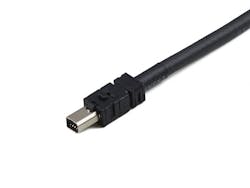Much of the focus on industrial Ethernet networks has centered on aspects such as topology and data transmission and storage. Receiving far less attention has been the fundamental issue of connection.
There’s no shortage of industrial connectors for all types of industrial cabling including, for example, the M5 to M23 range of connectors for data and power transmission. However, despite the existence of multiple housing and form factor options on the market, when it comes to Ethernet the standard method of connection remains the RJ45 connector—just like the one you use at home or in the front office. Of course, for industrial applications the RJ45 connector is more ruggedized to protect against environmental factors. But the RJ45 connector itself is largely the same.
But that doesn't mean engineers aren't working to improve on the RJ45 for industrial Ethernet applications.
At TE Connectivity, for example, they have developed the Mini I/O connector system, which has a mating face envelope that is only 25 percent of the size of an RJ45 Jack.
TE Connectivity partnered with another connector supplier, Amphenol FCI, to develop the original Mini I/O plug as well as enhanced versions that feature EMI (electro-magnetic interference) shielding and CAT6A signal integrity performance to meet expected future industrial communication standards. In late 2017, the Mini I/O connector was adopted by the International Electrotechnical Commission (IEC) under the international standard IEC 61076-3-122.
Under the IEC standardization of the Mini I/O, the connector can handle data transmission speeds up to 1 Gbps.
Guenter Feldmeier, global standardization and consortia leader of TE Connectivity’s industrial business unit, said that with acceptance of the technology under IEC 61076-3-122, the Mini-IO became “the first standardized, miniaturized industrial communication connector for an IP20 environment. Beyond its advantages for industrial applications in harsh environments, the small dimensions of the connector enable use of smaller devices and, therefore, higher packing densities inside cabinets.”
The Mini I/O connector differs from the RJ45—which was originally developed for use in telephone wiring—in that it was developed to be smaller and more reliable compared to the RJ45. According to a TE Connectivity white paper detailing Mini I/O connector technology, “The [Mini I/O] mating interface envelope reduction was realized by choosing fully enclosed metal shells, which…provide tight tolerances and mating interface stability.”
The white paper details testing of the Mini I/O against the RJ45 in comparable connection scenarios that exceeded the requirements of IEC 60603-7-3. In these tests, according to the paper, the Mini I/O performed best on several key performance criteria that are critical for industrial applications:
- Short discontinuities during vibration were lower due to a stable mechanical interface and double spring/double contact point layout.
- Resistance during cable movement was very stable during interface motions after environmental stress tests.
- EMI—screening attenuation of the Mini I/O was significantly better compared to all other RJ45 connectors tested.
To learn more about the Mini I/O connector, visit www.te.com/usa-en/products//connectors/modular-jacks-plugs/industrial-mini-i-o-connectors.html?source=header-match&tab=pgp-story.
To access the white paper referenced in this article, visit: www.te.com/usa-en/campaigns/industrial-solutions/mini-io-whitepaper-form.html


